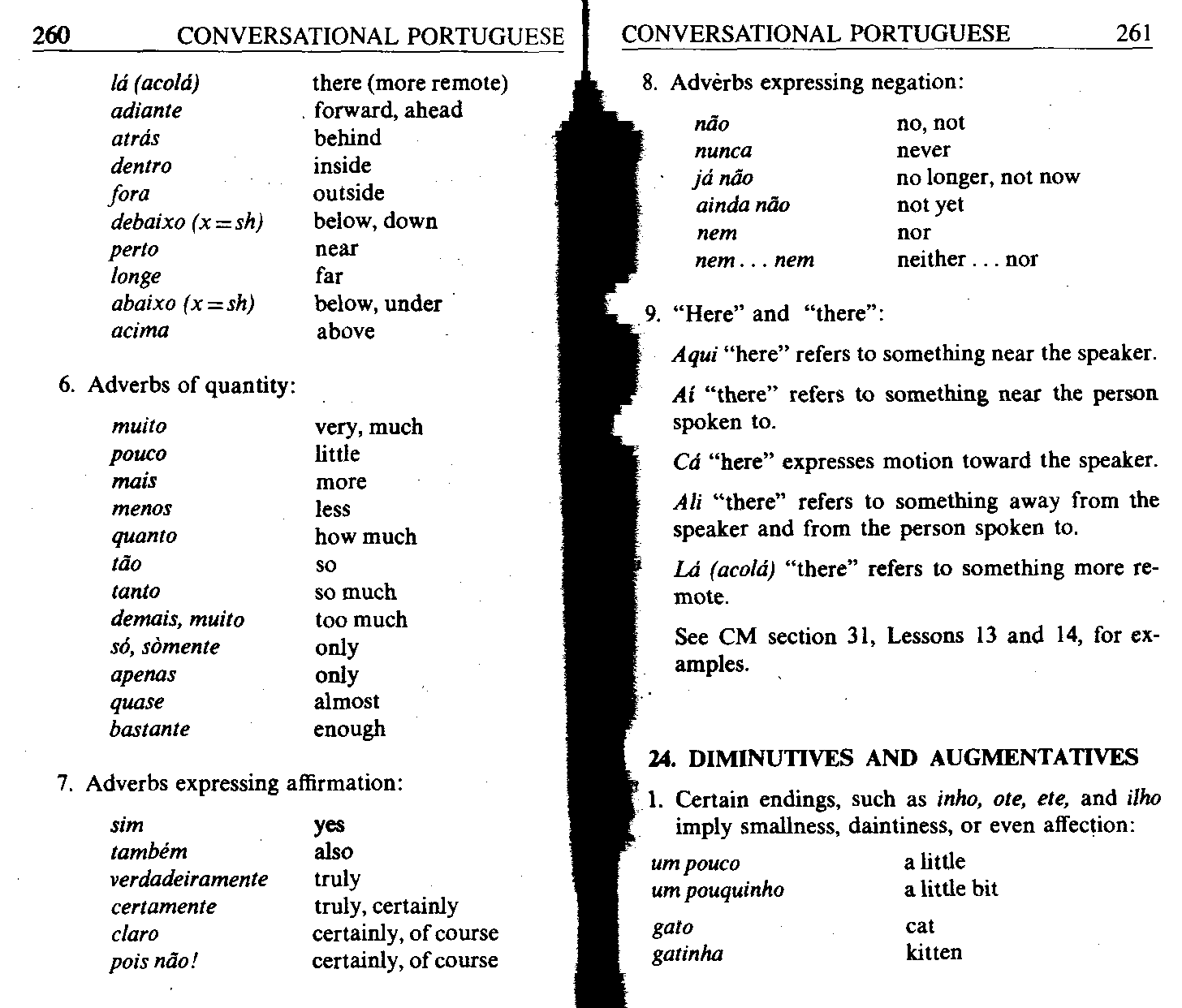Summary p260

260 CONYERSATIONAL PORTUGUESE
|
la (acold) |
there (morę remote) |
|
adiante |
. forward, ahead |
|
atrds |
behind |
|
dentro |
inside |
|
fora |
outside |
|
debaixo (x = sh) |
below, down |
|
perto |
near |
|
longe |
far |
|
abaixo (x=sh) |
below, under |
|
acima |
above |
|
dverbs of ąuantity: | |
|
muito |
very, much |
|
pouco |
little |
|
mais |
morę |
|
me nos |
less |
|
ąuanto |
how much |
|
tao |
so |
|
tanio |
so much |
|
de mais, muito |
too much |
|
só, sómente |
only |
|
apenas |
only |
|
ąuase |
almost |
|
bastante |
enough |
|
dverbs expressing affirmation: | |
|
sim |
yes |
|
tambem |
also |
|
verdadeiramente |
truły |
|
certamente |
truły, certainly |
|
claro |
certainly, of course |
|
pois nao! |
certainly, of course |
8. Adverbs expressing negation:
nao nunca ja nao ainda nao nem
nem... nem
no, not never
no longer, not now
not yet
nor
neither ... nor
9,
“Herc” and “there”:
Aąui “here” refers to something near the speaker.
At “there” refers to something near the person spoken to.
Cd “here” expresses motion toward the speaker.
Ali “there” refers to something away from the speaker and from the person spoken to.
La (acola) “there” refers to something morę re-mote.
See CM section 31, Lessons 13 and 14, for ex-amples.
24. DIMINUTIVES AND AUGMENTATIYES
1. Certain endings, such as inho, ote, ete, and ilho imply smallness, daintiness, or even affection:
urn pouco a little
um pouąuinho a little bit
cat
kitten
gato
gatinha
Wyszukiwarka
Podobne podstrony:
Summary p222 222 CONYERSATIONAL PORTUGUESE 21. Vamos_(to have dinner). a. jantar
Summary p224 224 CONYERSATIONAL PORTUGUESE (3) variations occur in different areas: a.
Summary p226 226 CONYERSATIONAL PORTUGUESH CONYERSATIONAL PORTUGUESE 227 d g g h j I I Ut m as d i
Summary p230 230 CONYERSATIONAL PORTUGUESE 3, The cedilla (cedilha) is used with
Summary p234 234 CONYERSATIONAL PORTUGUESE k. with parts of the body and articles of clothing inst
Summary p236 236 CONYERSATIONAL PORTUGUESE De and em combine with the demonstrative forms (see GS2
Summary p238 238 CONYERSATIONAL PORTUGUESE 13. MASCULINE AND FEMININE 238 CONYERSATIONAL PORTUGUES
Summary p240 240 CONYERSATIONAL PORTUGUESE 14. THE PLURAL 1. Nouns ending in a vowel, including na
Summary p242 242 CONYERSATIONAL PORTUGUESE seu can also be used to translate “his,” “her,” “their.
Summary p246 246 CONYERSATIONAL PORTUGUESE 1«. COMPAR1SON 1. Rcgular comparison facil easy ma
Summary p248 248 CONYERSATIONAL PORTUGUESE 19. PRONOUNS Pronouns have varying forms depending on w
Summary p250 250 CONYERSATIONAL PORTUGUESE CONYERSATIONAL PORTUGUESE_ 251 (te) I
Summary p254 254 CONYERSATIONAL PORTUGUESE Nao me escreva mais. Eles decidiram que nos mandar
Summary p256 256 CONYERSATIONAL PORTUGUESE 21. SOME CONJUNCTIONS ainda que assim que ate
Summary p258 258 CONYERSATIONAL PORTUGUESE 23. ADYERBS 1. Some Portuguese adverbs are formed by ad
Summary p262 262 CONYERSATIONAL PORTUGUESE sabdo soap sabonete a cake of toilet
Summary p264 264 CONYERSATIONAL PORTUGUESE Ndo ąuero este sem I don’t want this one
Summary p266 266 CONYERSATIONAL PORTUGUESE27. NEGATION 1. Ndo “not” comes before
Summary p268 268 CONYERSATIONAL PORTUGUESE 2. The personal infinitiye has endings which make it ea
więcej podobnych podstron